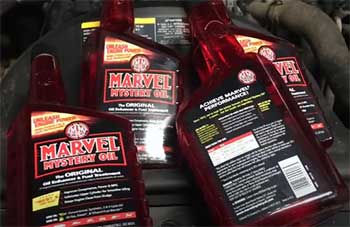Ceramic coatings have become increasingly popular in recent years as a way to protect and enhance the paint on cars, trucks, and other vehicles. Two of the most well-known brands for ceramic coatings are Ceramic Pro and Opti-Coat.
But how do you choose between them?
What are the key differences and which one is better? This comprehensive guide examines the pros, cons, features, and capabilities of Ceramic Pro and Opti-Coat to help you decide.
A Brief Comparison Table
| Feature | Ceramic Pro | Opti-Coat |
| Application | Professional installers | DIY-friendly |
| Number of layers | Multi-layer (2-7 coats) | Single stage |
| Main products | Ceramic Pro Sport, 9H | Opti-Coat Pro, Opti-Coat Pro+ |
| Durability | Up to 9 years | 5+ years |
| Gloss level | Very high gloss with multiple coats | High gloss, Pro+ is highest |
| Self-healing | No | Yes, flexible coating |
| Cost | $1000 – $4000+ professional install | $60 – $150 DIY kits |
| Customer service | Varies based on installer | Direct from Opti-Coat, very helpful |
| Overall consensus | Better for maximum gloss/protection | Easier DIY application |
What Is A Ceramic Coating?
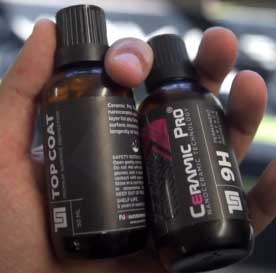
Before diving into the differences between Ceramic Pro and Opti-Coat, it’s helpful to understand what a ceramic coating actually is.
A ceramic coating is a liquid polymer that is applied to the exterior paint of a vehicle.
The coating bonds with the surface to form a glossy, hydrophobic layer that protects the paint.
Ceramic coatings create a protective barrier that makes the vehicle’s paint more resistant to scratches, uv damage, chemical staining from contaminants, and environmental factors like bird droppings.
The slick surface also makes it much easier to clean and wash the vehicle since dirt and debris have a harder time bonding.
Professional ceramic coatings last for several years if properly maintained, far surpassing traditional waxes that may need reapplication every few months.
While an initial professional application can be a significant investment, the long-term protection and gloss boost is often worth it for car enthusiasts and those wanting to maintain their vehicle’s appearance.
Also Read: Differences Between Sweet Patina And Poppy’s Patina Clear Coats.
Ceramic Pro Overview
Ceramic Pro is one of the original mainstream ceramic coating companies in the automotive appearance industry. They were one of the first brands to make ceramic coatings popular as an upgrade over traditional wax.
Ceramic Pro offers several different ceramic coating packages. Their flagship product is the 9H (9-year hardness rated) Ceramic Pro Sport coating system that consists of multiple layers for gloss and protection.
Some key facts about Ceramic Pro:
- Based in Thailand and sold internationally
- Available as a DIY coating or through professional authorized installers
- Packages for exterior and interior protection
- Advertises up to 9 years of protection with proper maintenance
- Multiple coating layers for thickness and gloss
- Evaluation for hardness on the “pencil hardness test”
Ceramic Pro promotes their coatings as being easy to clean, resistant to UV rays, scratch-resistant, hydrophobic, and offering a showroom shine when applied properly. Their multi-layer approach aims to provide complete protection for all surfaces, including glass.
Opti-Coat Overview
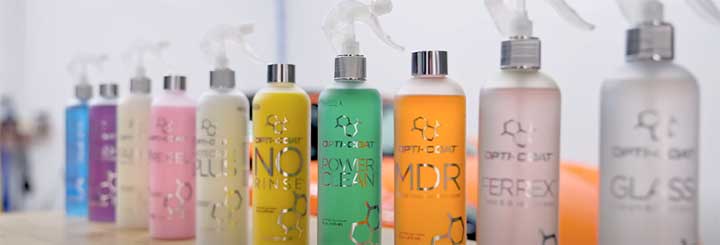
Opti-Coat is a flagship ceramic coating brand from AvalonKing that was introduced in 2010. They focus heavily on DIY-friendly ceramic coatings and making professional-grade protection accessible.
Opti-Coat offers two versions of their coating: Opti-Coat Pro and Opti-Coat Pro+. Both are single-stage coatings designed to create a durable, hydrophobic layer.
Key Opti-Coat features:
- Based in the USA and sold globally
- User-friendly DIY application
- Flagship product is Opti-Coat Pro
- Also offer Opti-Coat Pro+ version with added gloss
- Advertises 5+ years of protection (or longer)
- Evaluated for hardness on the “pencil test” just like Ceramic Pro
Opti-Coat aims to make ceramic coating technology easy to apply for beginners while still offering professional levels of protection. Their coatings repel dirt and contaminants, add shine, and provide a slick surface. Opti-Coat is also flexible which allows self-healing properties.
Comparing Application and Durability
One of the biggest differences between Ceramic Pro and Opti-Coat coatings is the application process. Ceramic Pro promotes a multi-layer process performed by authorized installers, while Opti-Coat can be applied by anyone as a single-stage coating.
- Ceramic Pro
Ceramic Pro requires professional application. Each package has 2-7 layers that are applied one after another for thickness and gloss. The application process takes extensive training and practice to master, so it is not intended as a DIY coating. Having an authorized shop apply Ceramic Pro ensures an optimal finish.
- Opti-Coat
Opti-Coat coatings are designed for simple DIY application in 1-2 layers. The products come ready to apply straight from the bottle. While professional application is recommended for an expert finish, Opti-Coat can easily be self-installed by car enthusiasts.
As for durability, both Ceramic Pro and Opti-Coat advertise multi-year protection from a full application:
- Ceramic Pro lifespan is advertised at 2-9 years depending on package
- Opti-Coat states their coatings provide 5+ years of protection
Independent tests of Opti-Coat and Ceramic Pro show excellent durability, hydrophobic properties, and resistance to contaminants. Assuming proper prep work, both offer long-term protection you would expect from a ceramic coating. Proper maintenance is required to maximize the lifespan.
Gloss Level Comparison
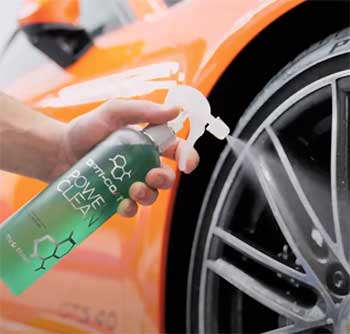
A major goal of any ceramic coating is to increase the paint’s gloss for an ultra-reflective wet look.
Ceramic Pro aims to maximize gloss through their multi-layer application process.
Having several coats adds depth and reflectivity.
Their higher tier packages like 9H promise extreme reflectivity from the layers of protective coating.
Opti-Coat coatings also enhance gloss significantly compared to bare paint.
Opti-Coat Pro+ is their higher gloss formula, taking shine to the next level.
While a single layer can’t match the deepest wet-look of a multi-layer coating, Opti-Coat still provides a slick, reflective surface when applied properly.
Both companies produce coatings that significantly boost the paint’s gloss. It comes down to specific products for the highest levels of reflectivity, like Ceramic Pro 9H or Opti-Coat Pro+.
Self-Healing and Flexibility
One unique benefit that Opti-Coat offers is self-healing properties. The coating is flexible, allowing it to partially fill in and repair minor swirls and scratches over time. While scratches should still be avoided, this flexibility helps maintain the appearance.
Ceramic Pro does not advertise the same self-healing characteristics. Their rigid glass-like coating provides excellent protection and gloss but does not flex or fill scratches on its own. Maintaining a Ceramic Pro coating requires avoiding paint damage as much as possible.
Also Read: Is RestorFX Better Than Ceramic Coating?
Cost Comparison
Since Ceramic Pro requires professional installation and Opti-Coat is a DIY coating, there is a significant price difference between the two brands:
- Ceramic Pro
Full kits from authorized installers range from $1000 to $4000+ depending on the tier and vehicle size. Their 9H kit for maximum protection and gloss is at the top of that pricing scale. The multi-layer process and labor is reflected in the cost.
- Opti-Coat
Opti-Coat Pro kits are currently priced around $60 to $100 depending on vehicle size, while Opti-Coat Pro+ is around $150. This makes it significantly more affordable as a DIY option, though professional installation still provides the best results.
For a professional finish, Ceramic Pro’s cost is often justified by the work involved and longevity promised through their multi-layer system. DIY enthusiasts find appeal in Opti-Coat’s pricing and ease of use. Both offer years of protection when properly applied.
Customer Service Reputation
Both Opti-Coat and Ceramic Pro have generally positive reputations when it comes to customer service:
- Ceramic Pro
As an international company working through installers, customer service experiences can vary. But Ceramic Pro’s training for authorized applicators and support for issues helps maintain positive feedback. There are some complaints of vendors upselling packages.
- Opti-Coat
Direct customer service and a helpful approach to DIY users gives Opti-Coat high marks. Their U.S. team is responsive to technical issues and provides guidance to first-time users of ceramic coatings during application.
Opti-Coat’s focus on consumer-friendly service gives them an edge for customer satisfaction. But both brands aim to provide a quality long-term product when properly applied.
Ease of Use
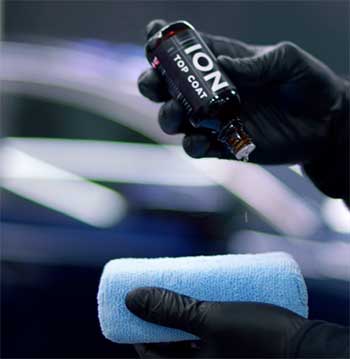
Opti-Coat clearly beats out Ceramic Pro when it comes to ease of use.
DIY ceramic coating users will find the application process much more straightforward.
Ceramic Pro requires extensive training to apply correctly.
The multi-layer process must be completed precisely to get the advertised durability and gloss.
While a professional shop makes application easy, it isn’t a DIY-friendly coating.
Opti-Coat is formulated to make ceramic coating application simple even for complete beginners.
The all-in-one products allow anyone to coat their vehicle at home with proper preparation. While not as easy as a traditional wax, Opti-Coat simplifies the ceramic coating process.
Quality and Results
Both Ceramic Pro and Opti-Coat produce professional-grade ceramic coatings that protect and enhance the paint when applied correctly.
Ceramic Pro’s multi-layer kits, when installed by authorized professionals, provide excellent gloss and longevity. Their flagship 9H coating tops the market in terms of reflectivity and hardness.
Opti-Coat coatings also perform extremely well based on independent testing. What you give up in multi-layer depth, you gain in accessibility and ease of maintenance. Opti-Coat’s single-stage application still provides long-lasting protection and hydrophobic properties.
Ultimately Ceramic Pro may have a slight edge in terms of coating performance, while Opti-Coat makes it simple for anyone to benefit from ceramic protection.
Also Read: Is PermaPlate Better Than Ceramic Coating?
Frequently Asked Questions (FAQ)
Opti-Coat Pro is the standard version of their ceramic coating, providing protection, hydrophobic properties, and enhanced gloss. Opti-Coat Pro+ uses advanced polymers to increase the gloss even further, creating an ultra-reflective coating. Both versions provide similar longevity when applied properly.
For professional multi-layer results, Ceramic Pro edges out Opti-Coat. But for user-friendly DIY application, Opti-Coat is much easier to apply with excellent results. It depends whether you prioritize DIY access or maximum coating performance. Both provide excellent protection when properly applied.
Opti-Coat states that their coatings provide protection for over 5 years. Independent tests confirm at least this level of durability when properly prepped, applied, and maintained. With care, Opti-Coat can exceed 5 years of protection.
Ceramic Pro advertises durability ranging from 2 years to 9+ years depending on the specific coating package. Their 9H coating promises around 9 years of protection with proper application prep and maintenance. Real-world longevity depends on usage and care.
Closing Remarks
Ceramic Pro and Opti-Coat both provide excellent gloss, protection, and longevity when properly applied. For maximum multi-layer performance from trained professionals, Ceramic Pro is a top choice. Their 9H coating offers unrivaled gloss and hardness.
But for user-friendly DIY application, Opti-Coat Pro and Pro+ make ceramic protection achievable for anyone. The single-stage application doesn’t require advanced training or multiple steps. Opti-Coat simplifies the use of ceramic coatings.
There’s no universally superior option between these two industry-leading brands. Your priorities and application approach will determine whether Ceramic Pro or Opti-Coat is the better choice.
With either of these coatings properly prepped and applied, your vehicle will stay protected for years to come.
